Assessment of Practices as an Enrolled Nurse in Australia
VerifiedAdded on 2020/04/21
|14
|2339
|144
Homework Assignment
AI Summary
This assignment delves into the practices of an enrolled nurse in Australia, addressing various aspects of patient care and professional conduct. It begins with the admission process, outlining the roles and responsibilities of an admission nurse, including patient assessment and medical history review. The assignment then explores effective communication strategies, emphasizing the importance of clear and empathetic communication with patients, especially those with conditions like Transient Ischaemic Attack (TIA). It also covers legal and ethical considerations, such as the use of interpreters, open disclosure of adverse events, and social media policies. Furthermore, the assignment examines practical nursing tasks like nursing handover procedures and the benefits of enterprise patient administration systems. The student also considers the role of feedback in improving performance and decision-making within a healthcare setting. The assignment provides a comprehensive overview of the challenges and responsibilities faced by enrolled nurses in the Australian healthcare system.
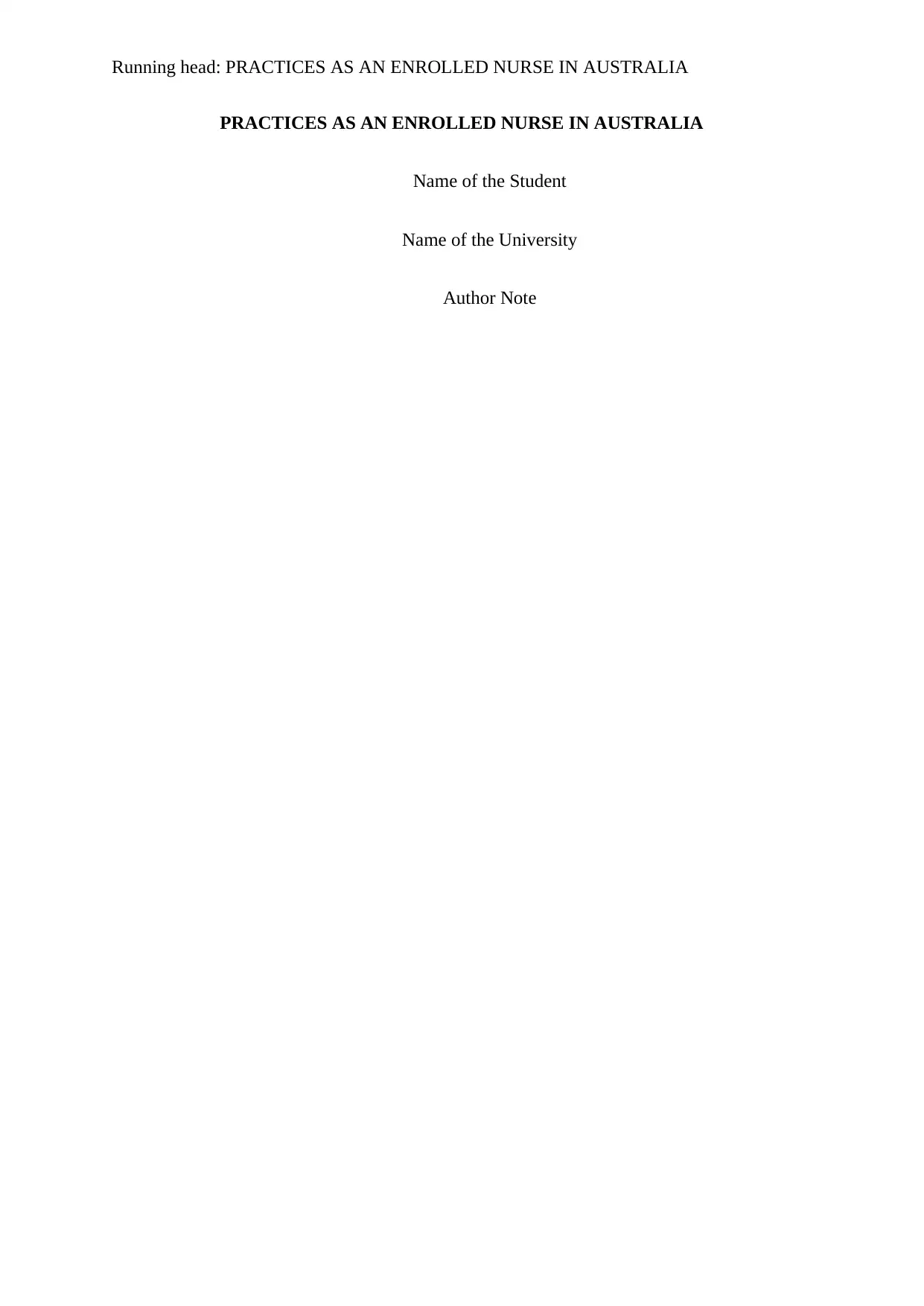
Running head: PRACTICES AS AN ENROLLED NURSE IN AUSTRALIA
PRACTICES AS AN ENROLLED NURSE IN AUSTRALIA
Name of the Student
Name of the University
Author Note
PRACTICES AS AN ENROLLED NURSE IN AUSTRALIA
Name of the Student
Name of the University
Author Note
Paraphrase This Document
Need a fresh take? Get an instant paraphrase of this document with our AI Paraphraser
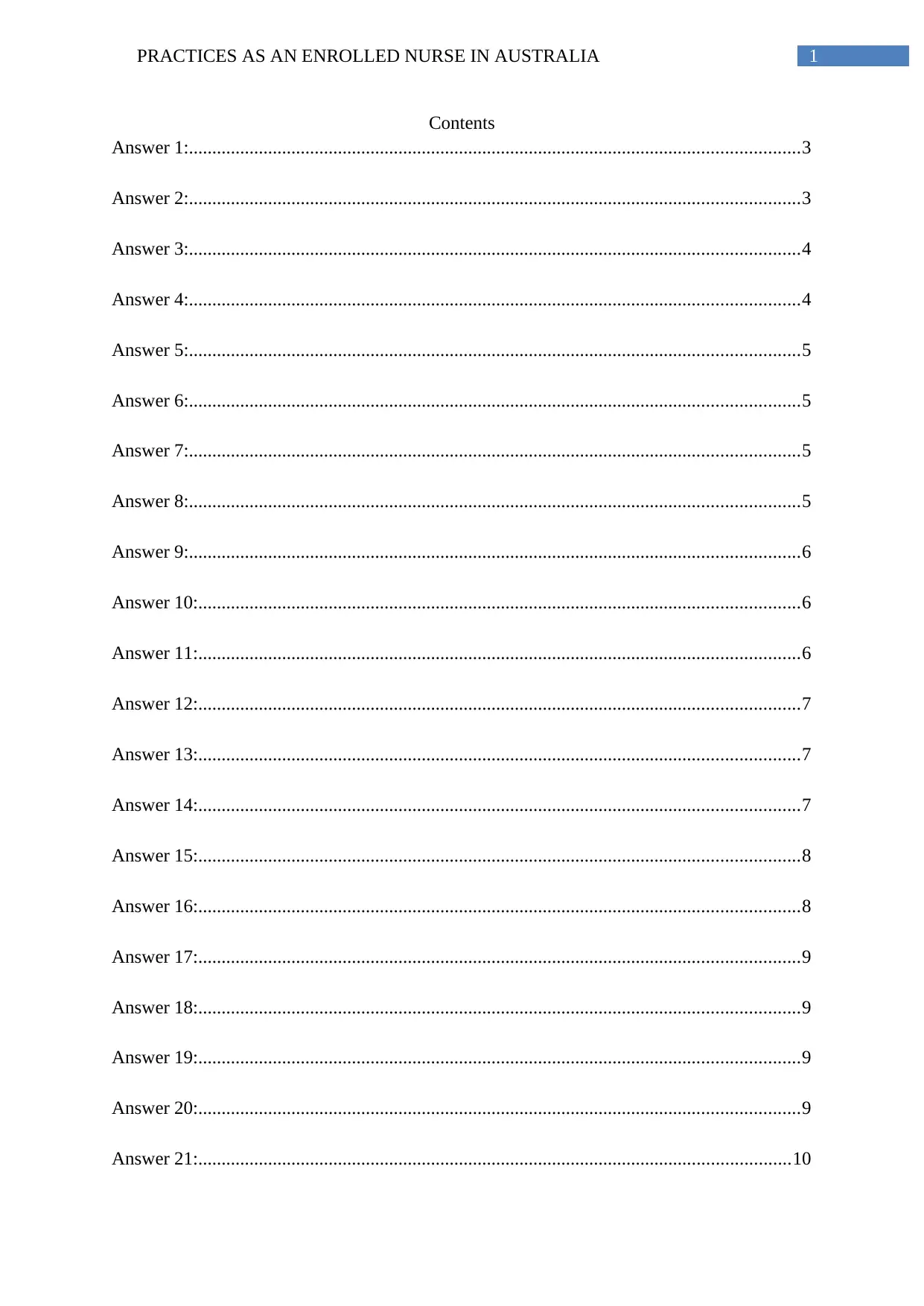
1PRACTICES AS AN ENROLLED NURSE IN AUSTRALIA
Contents
Answer 1:...................................................................................................................................3
Answer 2:...................................................................................................................................3
Answer 3:...................................................................................................................................4
Answer 4:...................................................................................................................................4
Answer 5:...................................................................................................................................5
Answer 6:...................................................................................................................................5
Answer 7:...................................................................................................................................5
Answer 8:...................................................................................................................................5
Answer 9:...................................................................................................................................6
Answer 10:.................................................................................................................................6
Answer 11:.................................................................................................................................6
Answer 12:.................................................................................................................................7
Answer 13:.................................................................................................................................7
Answer 14:.................................................................................................................................7
Answer 15:.................................................................................................................................8
Answer 16:.................................................................................................................................8
Answer 17:.................................................................................................................................9
Answer 18:.................................................................................................................................9
Answer 19:.................................................................................................................................9
Answer 20:.................................................................................................................................9
Answer 21:...............................................................................................................................10
Contents
Answer 1:...................................................................................................................................3
Answer 2:...................................................................................................................................3
Answer 3:...................................................................................................................................4
Answer 4:...................................................................................................................................4
Answer 5:...................................................................................................................................5
Answer 6:...................................................................................................................................5
Answer 7:...................................................................................................................................5
Answer 8:...................................................................................................................................5
Answer 9:...................................................................................................................................6
Answer 10:.................................................................................................................................6
Answer 11:.................................................................................................................................6
Answer 12:.................................................................................................................................7
Answer 13:.................................................................................................................................7
Answer 14:.................................................................................................................................7
Answer 15:.................................................................................................................................8
Answer 16:.................................................................................................................................8
Answer 17:.................................................................................................................................9
Answer 18:.................................................................................................................................9
Answer 19:.................................................................................................................................9
Answer 20:.................................................................................................................................9
Answer 21:...............................................................................................................................10
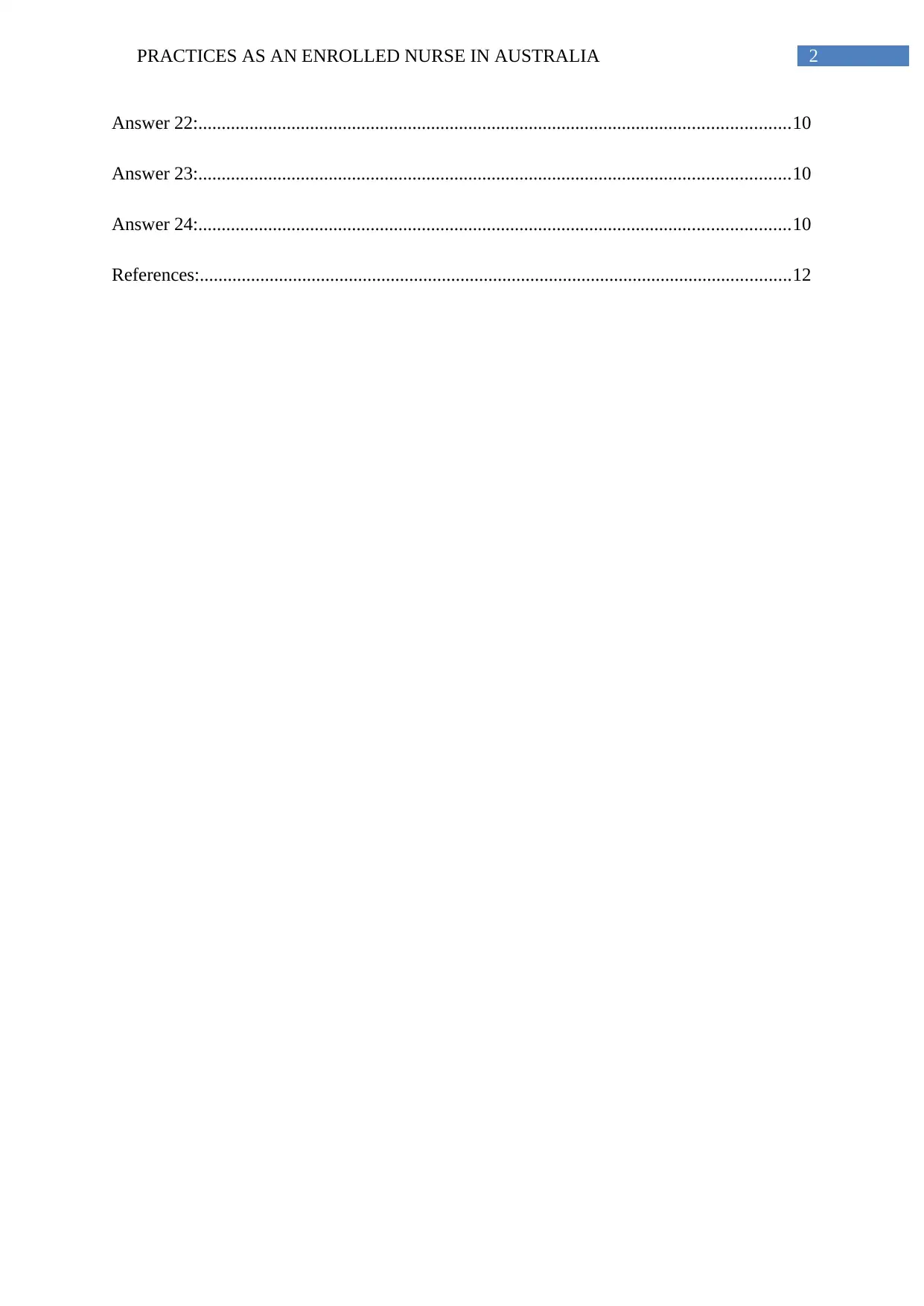
2PRACTICES AS AN ENROLLED NURSE IN AUSTRALIA
Answer 22:...............................................................................................................................10
Answer 23:...............................................................................................................................10
Answer 24:...............................................................................................................................10
References:...............................................................................................................................12
Answer 22:...............................................................................................................................10
Answer 23:...............................................................................................................................10
Answer 24:...............................................................................................................................10
References:...............................................................................................................................12
⊘ This is a preview!⊘
Do you want full access?
Subscribe today to unlock all pages.

Trusted by 1+ million students worldwide
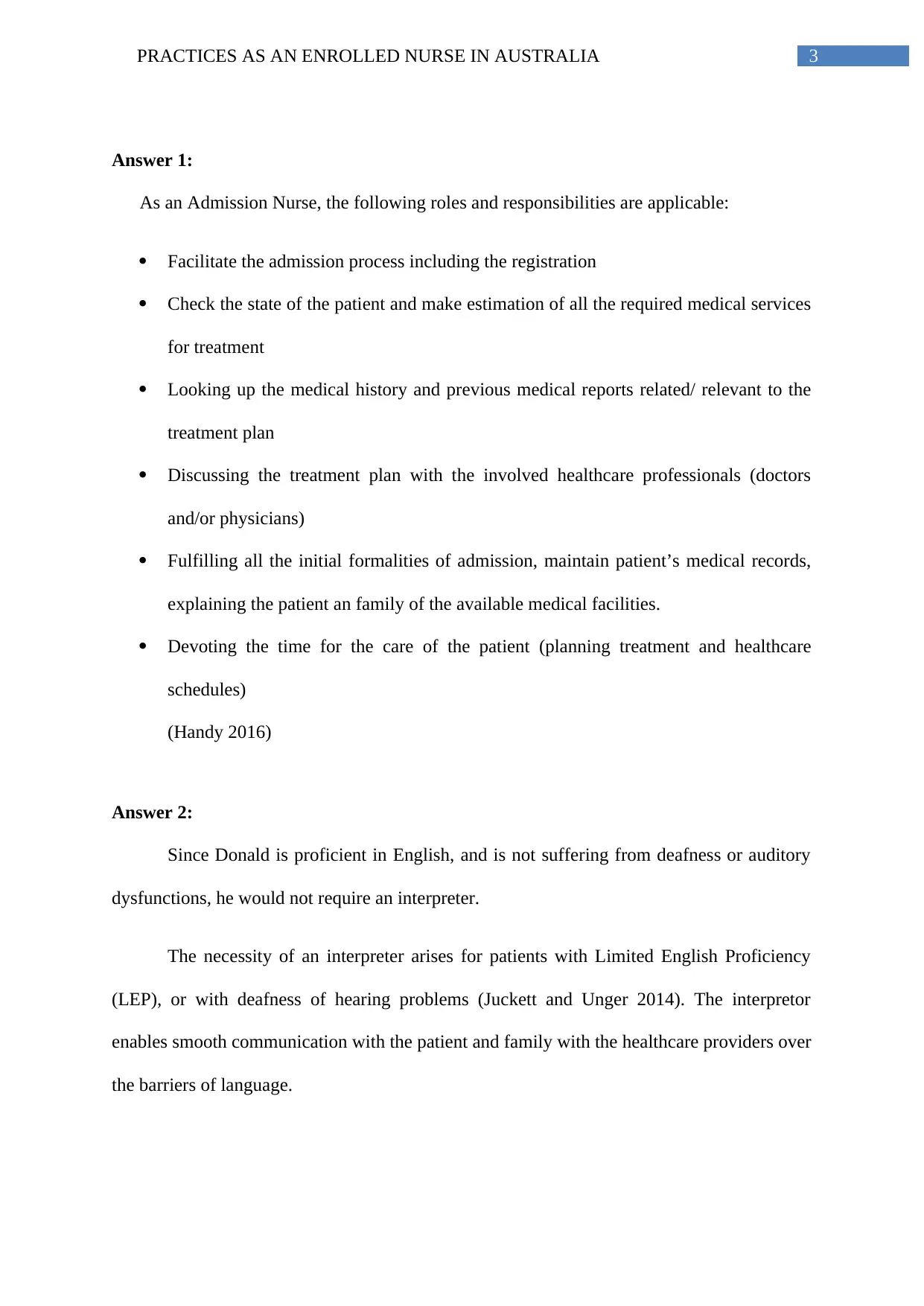
3PRACTICES AS AN ENROLLED NURSE IN AUSTRALIA
Answer 1:
As an Admission Nurse, the following roles and responsibilities are applicable:
Facilitate the admission process including the registration
Check the state of the patient and make estimation of all the required medical services
for treatment
Looking up the medical history and previous medical reports related/ relevant to the
treatment plan
Discussing the treatment plan with the involved healthcare professionals (doctors
and/or physicians)
Fulfilling all the initial formalities of admission, maintain patient’s medical records,
explaining the patient an family of the available medical facilities.
Devoting the time for the care of the patient (planning treatment and healthcare
schedules)
(Handy 2016)
Answer 2:
Since Donald is proficient in English, and is not suffering from deafness or auditory
dysfunctions, he would not require an interpreter.
The necessity of an interpreter arises for patients with Limited English Proficiency
(LEP), or with deafness of hearing problems (Juckett and Unger 2014). The interpretor
enables smooth communication with the patient and family with the healthcare providers over
the barriers of language.
Answer 1:
As an Admission Nurse, the following roles and responsibilities are applicable:
Facilitate the admission process including the registration
Check the state of the patient and make estimation of all the required medical services
for treatment
Looking up the medical history and previous medical reports related/ relevant to the
treatment plan
Discussing the treatment plan with the involved healthcare professionals (doctors
and/or physicians)
Fulfilling all the initial formalities of admission, maintain patient’s medical records,
explaining the patient an family of the available medical facilities.
Devoting the time for the care of the patient (planning treatment and healthcare
schedules)
(Handy 2016)
Answer 2:
Since Donald is proficient in English, and is not suffering from deafness or auditory
dysfunctions, he would not require an interpreter.
The necessity of an interpreter arises for patients with Limited English Proficiency
(LEP), or with deafness of hearing problems (Juckett and Unger 2014). The interpretor
enables smooth communication with the patient and family with the healthcare providers over
the barriers of language.
Paraphrase This Document
Need a fresh take? Get an instant paraphrase of this document with our AI Paraphraser
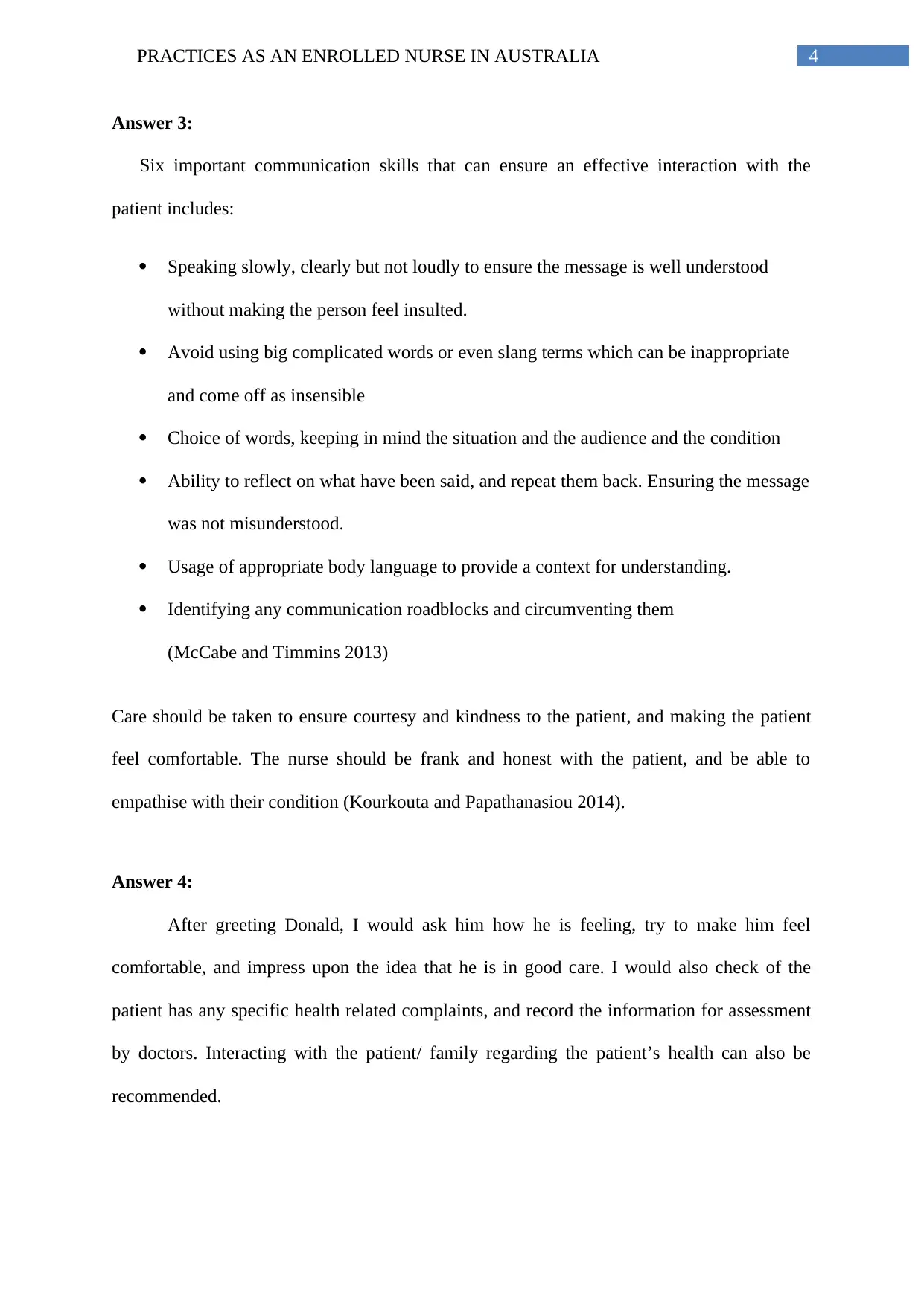
4PRACTICES AS AN ENROLLED NURSE IN AUSTRALIA
Answer 3:
Six important communication skills that can ensure an effective interaction with the
patient includes:
Speaking slowly, clearly but not loudly to ensure the message is well understood
without making the person feel insulted.
Avoid using big complicated words or even slang terms which can be inappropriate
and come off as insensible
Choice of words, keeping in mind the situation and the audience and the condition
Ability to reflect on what have been said, and repeat them back. Ensuring the message
was not misunderstood.
Usage of appropriate body language to provide a context for understanding.
Identifying any communication roadblocks and circumventing them
(McCabe and Timmins 2013)
Care should be taken to ensure courtesy and kindness to the patient, and making the patient
feel comfortable. The nurse should be frank and honest with the patient, and be able to
empathise with their condition (Kourkouta and Papathanasiou 2014).
Answer 4:
After greeting Donald, I would ask him how he is feeling, try to make him feel
comfortable, and impress upon the idea that he is in good care. I would also check of the
patient has any specific health related complaints, and record the information for assessment
by doctors. Interacting with the patient/ family regarding the patient’s health can also be
recommended.
Answer 3:
Six important communication skills that can ensure an effective interaction with the
patient includes:
Speaking slowly, clearly but not loudly to ensure the message is well understood
without making the person feel insulted.
Avoid using big complicated words or even slang terms which can be inappropriate
and come off as insensible
Choice of words, keeping in mind the situation and the audience and the condition
Ability to reflect on what have been said, and repeat them back. Ensuring the message
was not misunderstood.
Usage of appropriate body language to provide a context for understanding.
Identifying any communication roadblocks and circumventing them
(McCabe and Timmins 2013)
Care should be taken to ensure courtesy and kindness to the patient, and making the patient
feel comfortable. The nurse should be frank and honest with the patient, and be able to
empathise with their condition (Kourkouta and Papathanasiou 2014).
Answer 4:
After greeting Donald, I would ask him how he is feeling, try to make him feel
comfortable, and impress upon the idea that he is in good care. I would also check of the
patient has any specific health related complaints, and record the information for assessment
by doctors. Interacting with the patient/ family regarding the patient’s health can also be
recommended.
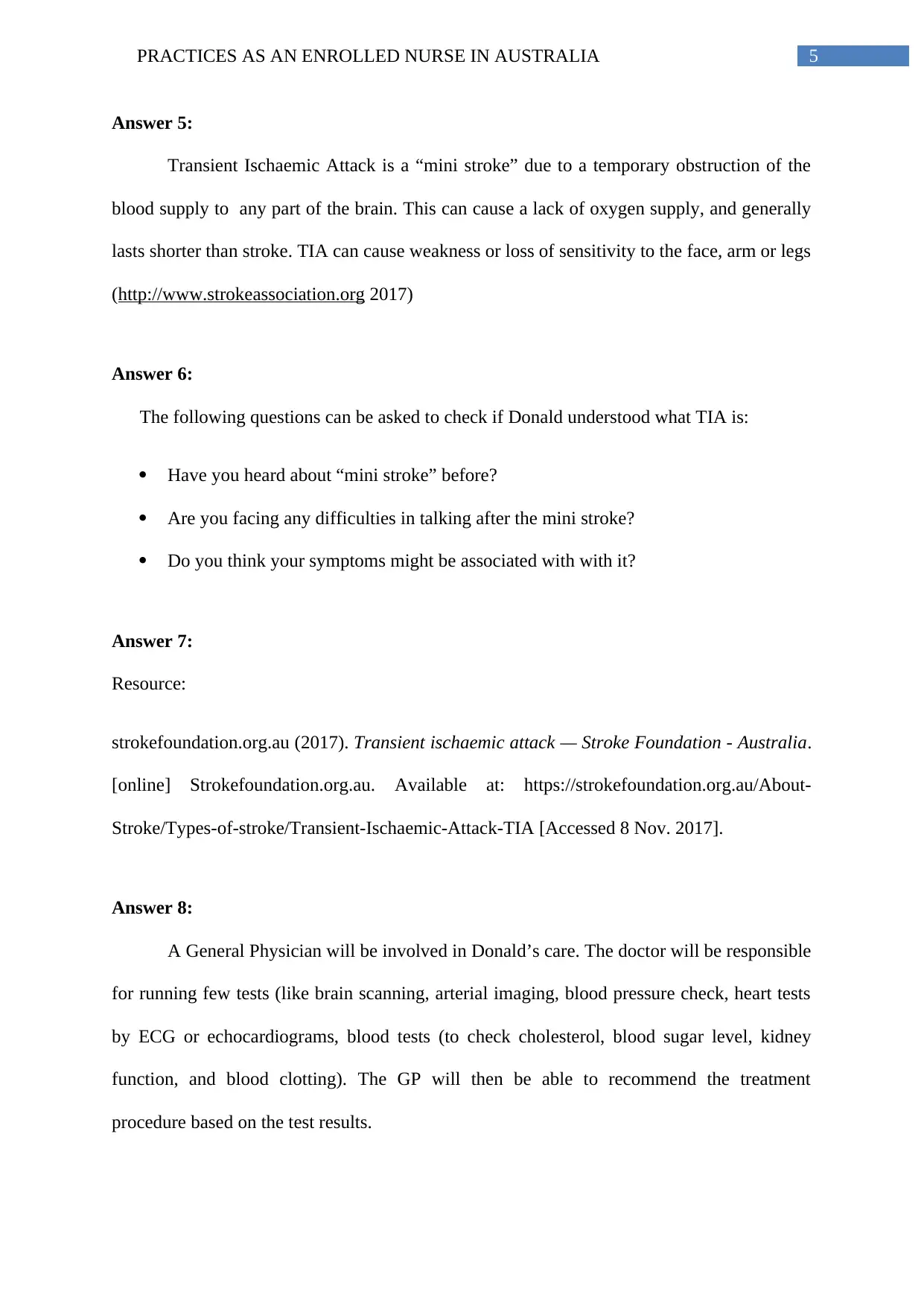
5PRACTICES AS AN ENROLLED NURSE IN AUSTRALIA
Answer 5:
Transient Ischaemic Attack is a “mini stroke” due to a temporary obstruction of the
blood supply to any part of the brain. This can cause a lack of oxygen supply, and generally
lasts shorter than stroke. TIA can cause weakness or loss of sensitivity to the face, arm or legs
(http://www.strokeassociation.org 2017)
Answer 6:
The following questions can be asked to check if Donald understood what TIA is:
Have you heard about “mini stroke” before?
Are you facing any difficulties in talking after the mini stroke?
Do you think your symptoms might be associated with with it?
Answer 7:
Resource:
strokefoundation.org.au (2017). Transient ischaemic attack — Stroke Foundation - Australia.
[online] Strokefoundation.org.au. Available at: https://strokefoundation.org.au/About-
Stroke/Types-of-stroke/Transient-Ischaemic-Attack-TIA [Accessed 8 Nov. 2017].
Answer 8:
A General Physician will be involved in Donald’s care. The doctor will be responsible
for running few tests (like brain scanning, arterial imaging, blood pressure check, heart tests
by ECG or echocardiograms, blood tests (to check cholesterol, blood sugar level, kidney
function, and blood clotting). The GP will then be able to recommend the treatment
procedure based on the test results.
Answer 5:
Transient Ischaemic Attack is a “mini stroke” due to a temporary obstruction of the
blood supply to any part of the brain. This can cause a lack of oxygen supply, and generally
lasts shorter than stroke. TIA can cause weakness or loss of sensitivity to the face, arm or legs
(http://www.strokeassociation.org 2017)
Answer 6:
The following questions can be asked to check if Donald understood what TIA is:
Have you heard about “mini stroke” before?
Are you facing any difficulties in talking after the mini stroke?
Do you think your symptoms might be associated with with it?
Answer 7:
Resource:
strokefoundation.org.au (2017). Transient ischaemic attack — Stroke Foundation - Australia.
[online] Strokefoundation.org.au. Available at: https://strokefoundation.org.au/About-
Stroke/Types-of-stroke/Transient-Ischaemic-Attack-TIA [Accessed 8 Nov. 2017].
Answer 8:
A General Physician will be involved in Donald’s care. The doctor will be responsible
for running few tests (like brain scanning, arterial imaging, blood pressure check, heart tests
by ECG or echocardiograms, blood tests (to check cholesterol, blood sugar level, kidney
function, and blood clotting). The GP will then be able to recommend the treatment
procedure based on the test results.
⊘ This is a preview!⊘
Do you want full access?
Subscribe today to unlock all pages.

Trusted by 1+ million students worldwide
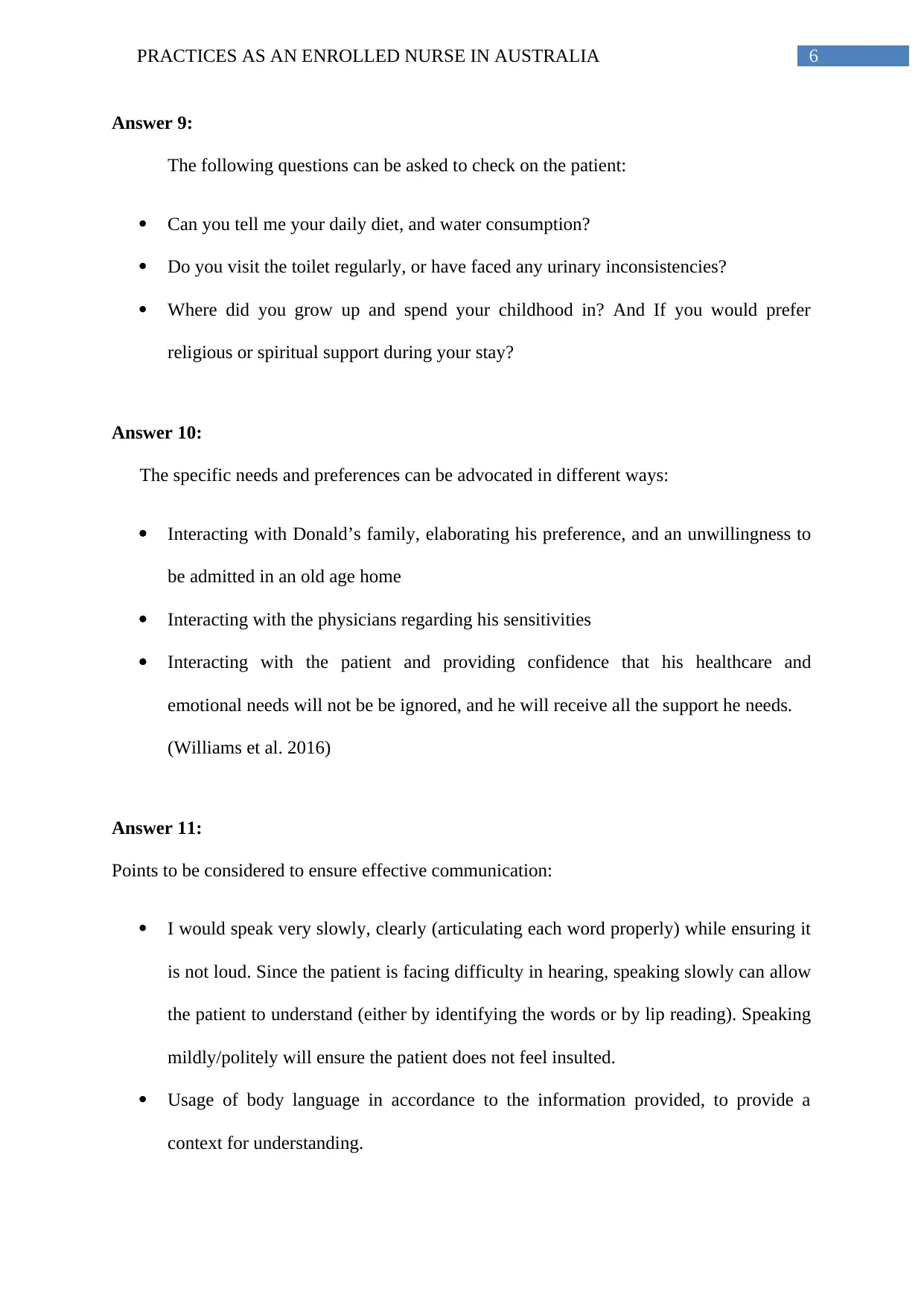
6PRACTICES AS AN ENROLLED NURSE IN AUSTRALIA
Answer 9:
The following questions can be asked to check on the patient:
Can you tell me your daily diet, and water consumption?
Do you visit the toilet regularly, or have faced any urinary inconsistencies?
Where did you grow up and spend your childhood in? And If you would prefer
religious or spiritual support during your stay?
Answer 10:
The specific needs and preferences can be advocated in different ways:
Interacting with Donald’s family, elaborating his preference, and an unwillingness to
be admitted in an old age home
Interacting with the physicians regarding his sensitivities
Interacting with the patient and providing confidence that his healthcare and
emotional needs will not be be ignored, and he will receive all the support he needs.
(Williams et al. 2016)
Answer 11:
Points to be considered to ensure effective communication:
I would speak very slowly, clearly (articulating each word properly) while ensuring it
is not loud. Since the patient is facing difficulty in hearing, speaking slowly can allow
the patient to understand (either by identifying the words or by lip reading). Speaking
mildly/politely will ensure the patient does not feel insulted.
Usage of body language in accordance to the information provided, to provide a
context for understanding.
Answer 9:
The following questions can be asked to check on the patient:
Can you tell me your daily diet, and water consumption?
Do you visit the toilet regularly, or have faced any urinary inconsistencies?
Where did you grow up and spend your childhood in? And If you would prefer
religious or spiritual support during your stay?
Answer 10:
The specific needs and preferences can be advocated in different ways:
Interacting with Donald’s family, elaborating his preference, and an unwillingness to
be admitted in an old age home
Interacting with the physicians regarding his sensitivities
Interacting with the patient and providing confidence that his healthcare and
emotional needs will not be be ignored, and he will receive all the support he needs.
(Williams et al. 2016)
Answer 11:
Points to be considered to ensure effective communication:
I would speak very slowly, clearly (articulating each word properly) while ensuring it
is not loud. Since the patient is facing difficulty in hearing, speaking slowly can allow
the patient to understand (either by identifying the words or by lip reading). Speaking
mildly/politely will ensure the patient does not feel insulted.
Usage of body language in accordance to the information provided, to provide a
context for understanding.
Paraphrase This Document
Need a fresh take? Get an instant paraphrase of this document with our AI Paraphraser
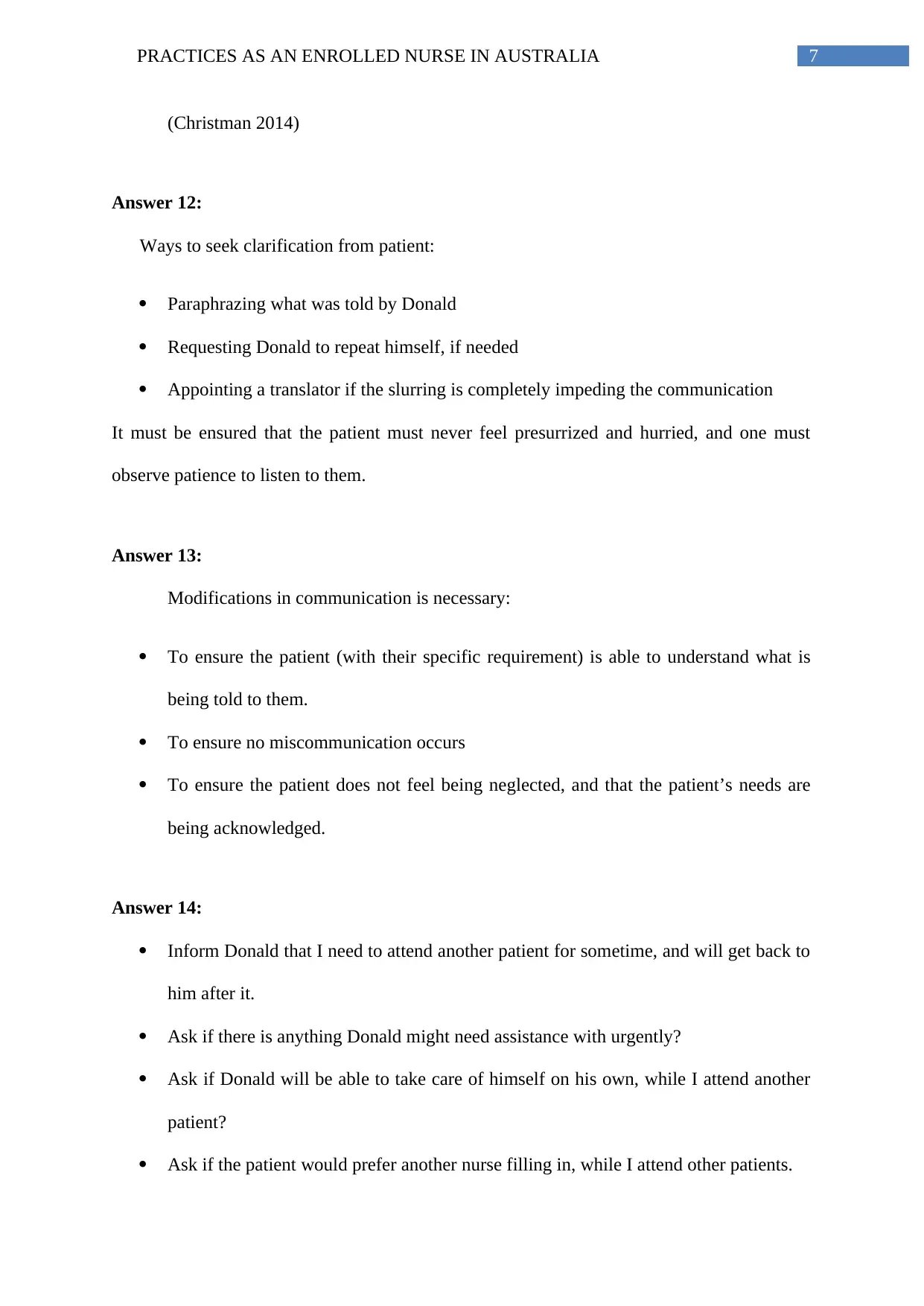
7PRACTICES AS AN ENROLLED NURSE IN AUSTRALIA
(Christman 2014)
Answer 12:
Ways to seek clarification from patient:
Paraphrazing what was told by Donald
Requesting Donald to repeat himself, if needed
Appointing a translator if the slurring is completely impeding the communication
It must be ensured that the patient must never feel presurrized and hurried, and one must
observe patience to listen to them.
Answer 13:
Modifications in communication is necessary:
To ensure the patient (with their specific requirement) is able to understand what is
being told to them.
To ensure no miscommunication occurs
To ensure the patient does not feel being neglected, and that the patient’s needs are
being acknowledged.
Answer 14:
Inform Donald that I need to attend another patient for sometime, and will get back to
him after it.
Ask if there is anything Donald might need assistance with urgently?
Ask if Donald will be able to take care of himself on his own, while I attend another
patient?
Ask if the patient would prefer another nurse filling in, while I attend other patients.
(Christman 2014)
Answer 12:
Ways to seek clarification from patient:
Paraphrazing what was told by Donald
Requesting Donald to repeat himself, if needed
Appointing a translator if the slurring is completely impeding the communication
It must be ensured that the patient must never feel presurrized and hurried, and one must
observe patience to listen to them.
Answer 13:
Modifications in communication is necessary:
To ensure the patient (with their specific requirement) is able to understand what is
being told to them.
To ensure no miscommunication occurs
To ensure the patient does not feel being neglected, and that the patient’s needs are
being acknowledged.
Answer 14:
Inform Donald that I need to attend another patient for sometime, and will get back to
him after it.
Ask if there is anything Donald might need assistance with urgently?
Ask if Donald will be able to take care of himself on his own, while I attend another
patient?
Ask if the patient would prefer another nurse filling in, while I attend other patients.
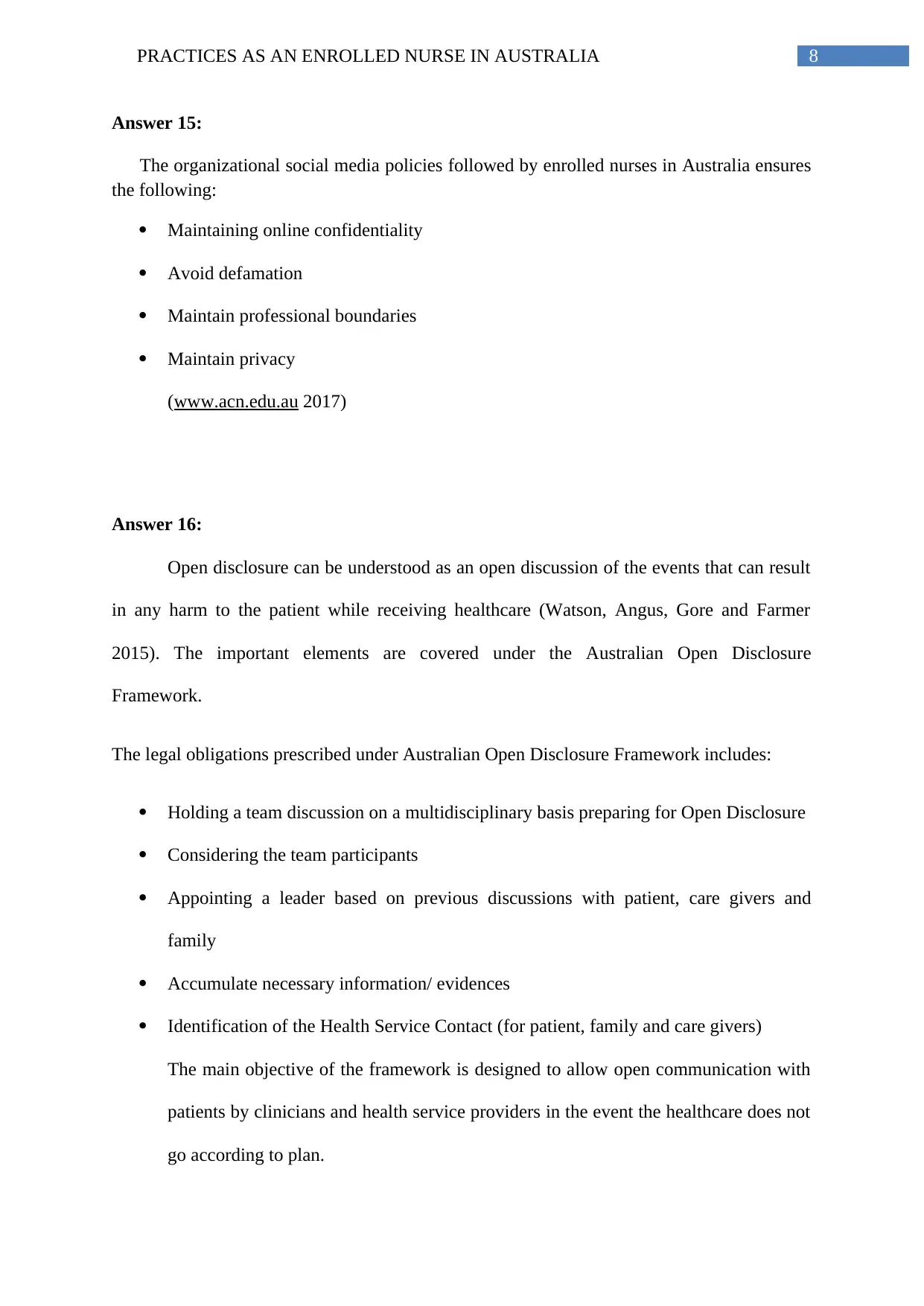
8PRACTICES AS AN ENROLLED NURSE IN AUSTRALIA
Answer 15:
The organizational social media policies followed by enrolled nurses in Australia ensures
the following:
Maintaining online confidentiality
Avoid defamation
Maintain professional boundaries
Maintain privacy
(www.acn.edu.au 2017)
Answer 16:
Open disclosure can be understood as an open discussion of the events that can result
in any harm to the patient while receiving healthcare (Watson, Angus, Gore and Farmer
2015). The important elements are covered under the Australian Open Disclosure
Framework.
The legal obligations prescribed under Australian Open Disclosure Framework includes:
Holding a team discussion on a multidisciplinary basis preparing for Open Disclosure
Considering the team participants
Appointing a leader based on previous discussions with patient, care givers and
family
Accumulate necessary information/ evidences
Identification of the Health Service Contact (for patient, family and care givers)
The main objective of the framework is designed to allow open communication with
patients by clinicians and health service providers in the event the healthcare does not
go according to plan.
Answer 15:
The organizational social media policies followed by enrolled nurses in Australia ensures
the following:
Maintaining online confidentiality
Avoid defamation
Maintain professional boundaries
Maintain privacy
(www.acn.edu.au 2017)
Answer 16:
Open disclosure can be understood as an open discussion of the events that can result
in any harm to the patient while receiving healthcare (Watson, Angus, Gore and Farmer
2015). The important elements are covered under the Australian Open Disclosure
Framework.
The legal obligations prescribed under Australian Open Disclosure Framework includes:
Holding a team discussion on a multidisciplinary basis preparing for Open Disclosure
Considering the team participants
Appointing a leader based on previous discussions with patient, care givers and
family
Accumulate necessary information/ evidences
Identification of the Health Service Contact (for patient, family and care givers)
The main objective of the framework is designed to allow open communication with
patients by clinicians and health service providers in the event the healthcare does not
go according to plan.
⊘ This is a preview!⊘
Do you want full access?
Subscribe today to unlock all pages.

Trusted by 1+ million students worldwide
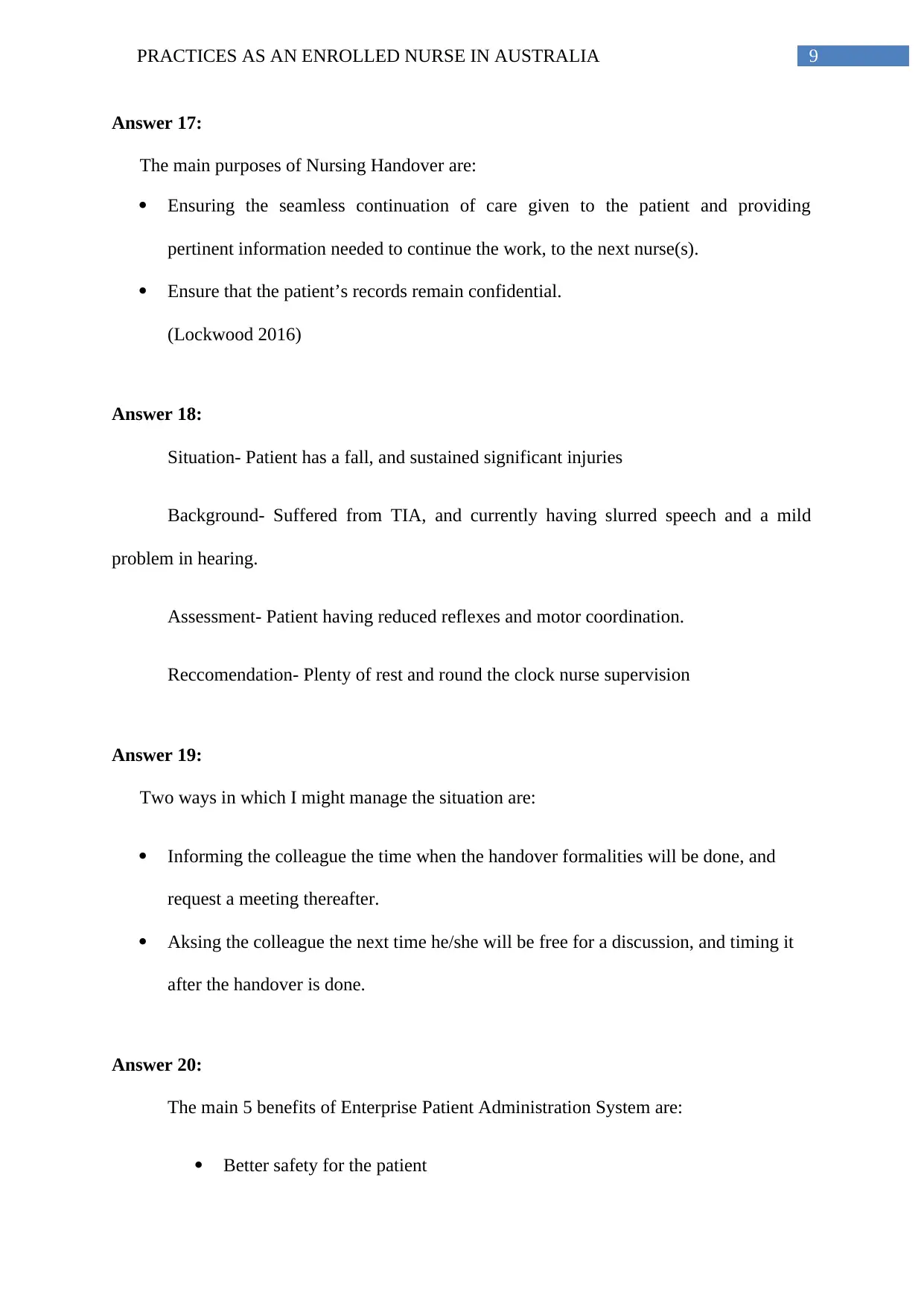
9PRACTICES AS AN ENROLLED NURSE IN AUSTRALIA
Answer 17:
The main purposes of Nursing Handover are:
Ensuring the seamless continuation of care given to the patient and providing
pertinent information needed to continue the work, to the next nurse(s).
Ensure that the patient’s records remain confidential.
(Lockwood 2016)
Answer 18:
Situation- Patient has a fall, and sustained significant injuries
Background- Suffered from TIA, and currently having slurred speech and a mild
problem in hearing.
Assessment- Patient having reduced reflexes and motor coordination.
Reccomendation- Plenty of rest and round the clock nurse supervision
Answer 19:
Two ways in which I might manage the situation are:
Informing the colleague the time when the handover formalities will be done, and
request a meeting thereafter.
Aksing the colleague the next time he/she will be free for a discussion, and timing it
after the handover is done.
Answer 20:
The main 5 benefits of Enterprise Patient Administration System are:
Better safety for the patient
Answer 17:
The main purposes of Nursing Handover are:
Ensuring the seamless continuation of care given to the patient and providing
pertinent information needed to continue the work, to the next nurse(s).
Ensure that the patient’s records remain confidential.
(Lockwood 2016)
Answer 18:
Situation- Patient has a fall, and sustained significant injuries
Background- Suffered from TIA, and currently having slurred speech and a mild
problem in hearing.
Assessment- Patient having reduced reflexes and motor coordination.
Reccomendation- Plenty of rest and round the clock nurse supervision
Answer 19:
Two ways in which I might manage the situation are:
Informing the colleague the time when the handover formalities will be done, and
request a meeting thereafter.
Aksing the colleague the next time he/she will be free for a discussion, and timing it
after the handover is done.
Answer 20:
The main 5 benefits of Enterprise Patient Administration System are:
Better safety for the patient
Paraphrase This Document
Need a fresh take? Get an instant paraphrase of this document with our AI Paraphraser
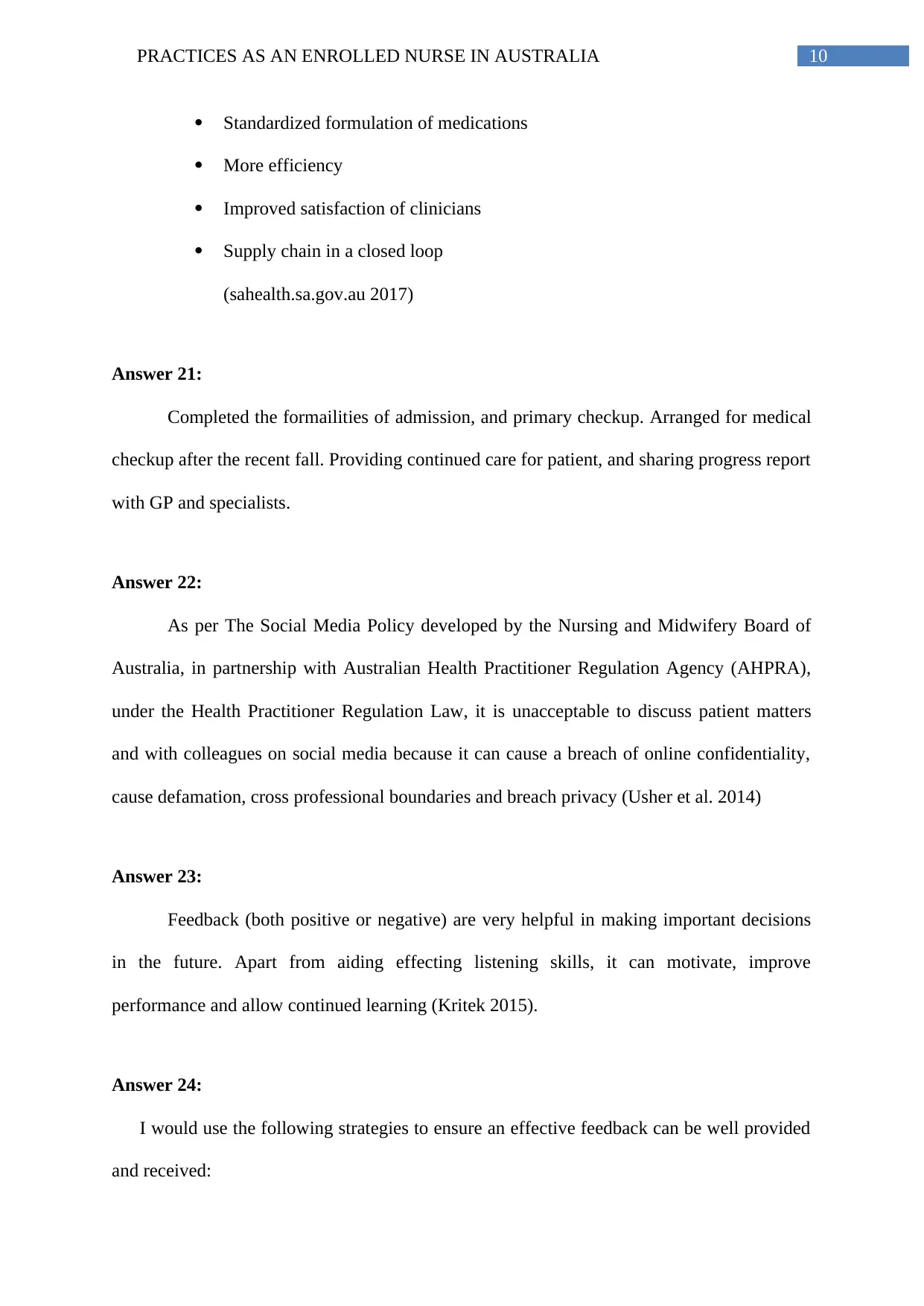
10PRACTICES AS AN ENROLLED NURSE IN AUSTRALIA
Standardized formulation of medications
More efficiency
Improved satisfaction of clinicians
Supply chain in a closed loop
(sahealth.sa.gov.au 2017)
Answer 21:
Completed the formailities of admission, and primary checkup. Arranged for medical
checkup after the recent fall. Providing continued care for patient, and sharing progress report
with GP and specialists.
Answer 22:
As per The Social Media Policy developed by the Nursing and Midwifery Board of
Australia, in partnership with Australian Health Practitioner Regulation Agency (AHPRA),
under the Health Practitioner Regulation Law, it is unacceptable to discuss patient matters
and with colleagues on social media because it can cause a breach of online confidentiality,
cause defamation, cross professional boundaries and breach privacy (Usher et al. 2014)
Answer 23:
Feedback (both positive or negative) are very helpful in making important decisions
in the future. Apart from aiding effecting listening skills, it can motivate, improve
performance and allow continued learning (Kritek 2015).
Answer 24:
I would use the following strategies to ensure an effective feedback can be well provided
and received:
Standardized formulation of medications
More efficiency
Improved satisfaction of clinicians
Supply chain in a closed loop
(sahealth.sa.gov.au 2017)
Answer 21:
Completed the formailities of admission, and primary checkup. Arranged for medical
checkup after the recent fall. Providing continued care for patient, and sharing progress report
with GP and specialists.
Answer 22:
As per The Social Media Policy developed by the Nursing and Midwifery Board of
Australia, in partnership with Australian Health Practitioner Regulation Agency (AHPRA),
under the Health Practitioner Regulation Law, it is unacceptable to discuss patient matters
and with colleagues on social media because it can cause a breach of online confidentiality,
cause defamation, cross professional boundaries and breach privacy (Usher et al. 2014)
Answer 23:
Feedback (both positive or negative) are very helpful in making important decisions
in the future. Apart from aiding effecting listening skills, it can motivate, improve
performance and allow continued learning (Kritek 2015).
Answer 24:
I would use the following strategies to ensure an effective feedback can be well provided
and received:
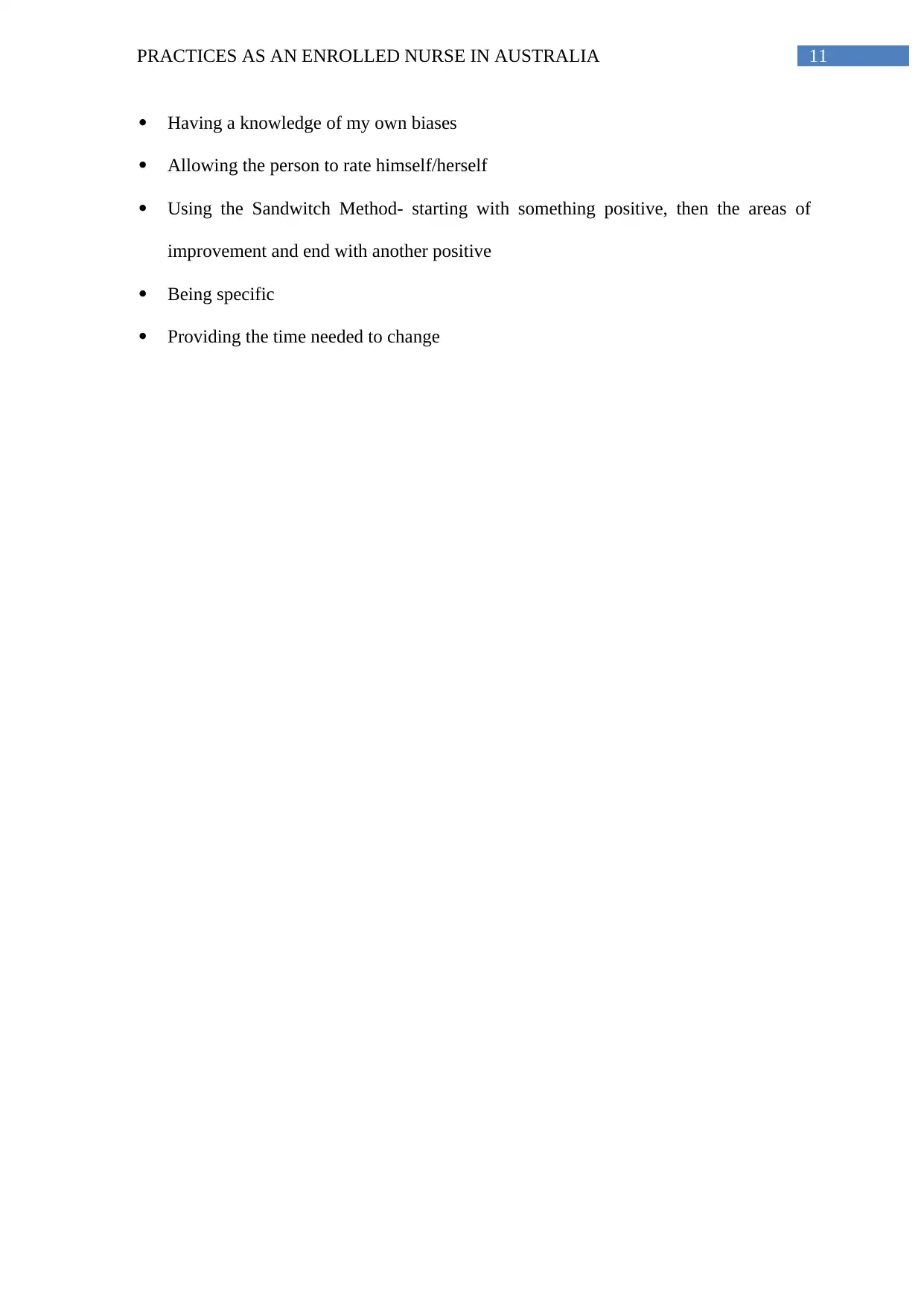
11PRACTICES AS AN ENROLLED NURSE IN AUSTRALIA
Having a knowledge of my own biases
Allowing the person to rate himself/herself
Using the Sandwitch Method- starting with something positive, then the areas of
improvement and end with another positive
Being specific
Providing the time needed to change
Having a knowledge of my own biases
Allowing the person to rate himself/herself
Using the Sandwitch Method- starting with something positive, then the areas of
improvement and end with another positive
Being specific
Providing the time needed to change
⊘ This is a preview!⊘
Do you want full access?
Subscribe today to unlock all pages.

Trusted by 1+ million students worldwide
1 out of 14
Related Documents
Your All-in-One AI-Powered Toolkit for Academic Success.
+13062052269
info@desklib.com
Available 24*7 on WhatsApp / Email
![[object Object]](/_next/static/media/star-bottom.7253800d.svg)
Unlock your academic potential
Copyright © 2020–2025 A2Z Services. All Rights Reserved. Developed and managed by ZUCOL.





